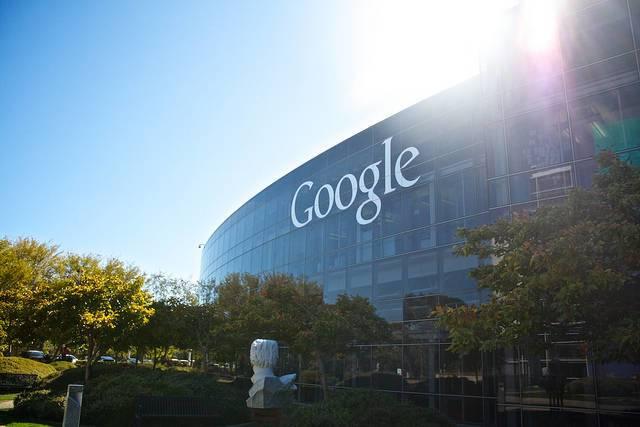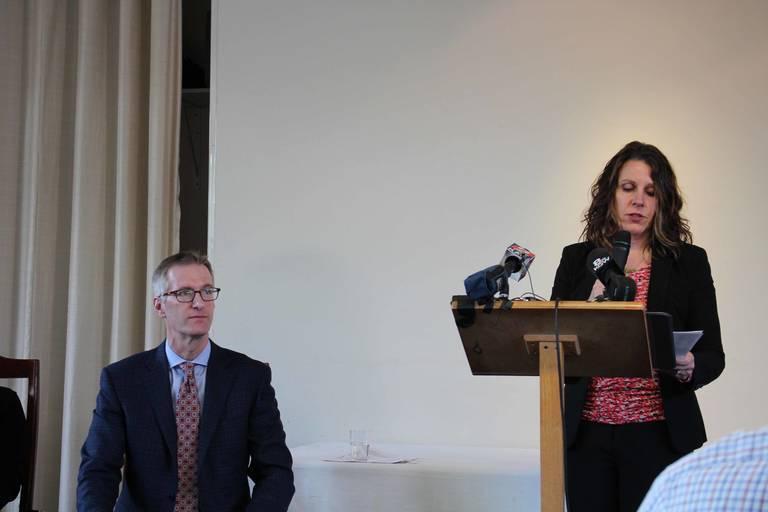Google Fights Back Against Pay Inequality Accusations


Not so fast, Google.
The Department of Labor had some surprising words for the tech giant last week after it claimed to have “closed the gender gap globally,” a first for the technology industry. Google’s revelation came in the form of a tweet, citing its own compensation analysis.
The DOL however, disagreed, revealing this week that Google is being sued by the federal government after the company refused to share employment data it is required to disclose by law.
“Discrimination against women in Google is quite extreme," Janet Herold, a lawyer for the DOL, told the Guardian earlier this week. While the DOL investigation isn’t complete, Herold said the agency already found “compelling evidence of very significant discrimination against women in the most common positions at Google headquarters” in Mountain View, California.
Her comments follow court testimony by DOL Regional Director Janette Wipper last Friday, who said the agency found “systematic compensation disparities pretty much across the entire workforce.”
But Google isn’t taking these statements sitting down. The company launched an aggressive effort to discredit the accusations, starting with a blog post written by its vice president of people operations, Eileen Naughton.
Naughton said the DOL request was too broad, “seeking thousands of employee records including contact details for our employees.”
The company also insists it has worked hard to establish its own metrics, and that the DOL isn’t reading the data correctly.
Google’s pay grade for each employment position is "blind to gender,” Naughton argued, meaning it doesn’t take personal information into account. Managers are also restricted in making pay adjustments and must account for such decisions with clear and acceptable criteria.
“Our analysis gives us confidence that there is no gender pay gap at Google. In fact, we recently expanded our analysis to cover race in the U.S.,” Naughton wrote.
But while Google sounds confident it’s come up with a fail-poof way to ensure there are no pay inequities in its ranks, other analysts are still asking questions.
“But pay inequity is a stubborn, systemic problem. It would shock me to find a big company without any gender pay gap,” Joelle Emerson, CEO and founder of Paradigm, tweeted on Friday. She added that looking at people in identical employment titles isn’t enough. “Not having access to certain roles is part of what produces the gap.”
Elizabeth Ames, senior vice president of marketing, alliances and programs at the Anita Borg Institute, an organization that focuses on gender diversity issues in the tech industry, noted that there are a lot more details that go into analyzing gender parity – details Naughton didn’t mention in her post.
These factors include employee retention (an issue that has been brought up before when it comes to analyzing gender parity in the tech industry), parity not only in advancement opportunities but actual promotions to managerial positions, how comfortable women and men feel about taking advantage of parental leave benefits, and parity in how visible female managers are in the public eye compared to male managers.
TriplePundit has discussed additional aspects of the pay parity conversation as well. Equal access to mentoring and feedback and ensuring a safe environment for employees to pursue new opportunities are issues that aren’t as easily interpreted in data analysis of employee hires.
Google has been one of the most outspoken advocates of gender equity in the tech industry, so it’s worth asking if this debate isn’t largely a matter of semantics and methodology. Should the DOL really be looking at the methodology Google uses to create gender parity? And has Google taken into account what the federal government considers evidence of an uneven playing field for women, men and minority applicants?
With many of the larger players in the tech industry now acknowledging that gender and ethnic discrimination must be eradicated, there’s even more need for consensus about what illustrates parity when it comes to hiring and work opportunities. Gender equality is often defined on the work floor and in everyday, subjective experience, and less by algorithms and data analysis of how employees are hired or paid.
Image credit: Flickr/Nihab
EPA Seeks Public Comment on Which Environmental Regs to Axe


As the Donald Trump administration pulls out all the stops in reversing just about anything bearing Barack Obama’s handprint – including, of course, environmental regulations – the Environmental Protection Agency is seeking public comment on its current slate of rules.
The EPA’s Regulatory Reform Task Force submitted a Federal Register notice on Tuesday that outlines the recommendations it is seeking from the general public. The task force in particular is soliciting comments that identify regulations linked to the elimination of jobs, are outdated or ineffective, “create a serious inconsistency,” or are based on data the administration deems as “insufficiently transparent to meet the standard of reproducibility.”
In explaining the calls for public comment, EPA Administrator Scott Pruitt said, “The previous administration abused the regulatory process to advance an ideological agenda that expanded the reach of the federal government.” By documenting feedback from individuals that have been affected by EPA regulations, Pruitt said the agency could partner with state and local governments to “ensure that we can provide clean air, land and water to Americans.”
The new task force, which began taking shape on Feb. 24 after one of the White House’s first executive orders targeting the EPA, has been instructed to “lower regulatory burdens on the American people.”
Among the many rules implemented by the Obama administration that has been -- or will be -- axed by Donald Trump and his supporting team is the requirement that government agencies no longer incorporate the social cost of carbon when evaluating the impact of new regulations or programs.
Meanwhile, a federal appeals court paused a lawsuit filed against the EPA over a 2015 ozone pollution rule.
The Trump administration requested the delay last week as the EPA mulls whether it wants to repeal the rule outright or adopt a different tactic on the issue, The Hill reported on Wednesday. The rule calls for the allowable concentration of ozone in the air to be lowered from 75 to 70 parts per billion -- which led energy companies, business groups and some states to take the EPA to court.
By requesting public comment, the new team leading the EPA could score more ammunition in supporting its agenda to overturn regulations implemented over the previous decade. But the sword cuts both ways: Environmental groups -- as well as clean-energy and technology companies, along with attorneys and policy experts committed to their cause -- could just as well relentlessly submit their comments and feedback over the next month.
Such tactics are analogous to the sudden end of the “repeal and replace movement” to gut the Affordable Care Act. The pitchforks were aimed and ready to eliminate Obamacare, until many citizens realized that it was not only “undeserving” folks who could lose affordable health care, but that they, too, risked losing their prized ease of access to doctors and cost-effective prescription drugs. Could the Trump administration be opening another door that, in a few weeks, they may wish they had left shut?
After all, the administration, through its EPA task force, says it wants “input” from NGOs, tribal governments, consumers, small businesses and local governments. They could very well score copious amounts of comments – only not quite the kind of feedback they hoped.
Image credit: urbanfeel/Flickr
Maryland Passes America's First Tax Credit for Energy Storage


Tax credits for renewable energy projects, such as solar and wind installations, cheer clean-technology advocates and flummox opponents. While recent advances in design helped these technologies generate renewable power far more efficiently and cheaply, it is hard to argue against the role tax credits and other financial incentives played in giving these new sources of power a lift.
What if similar developments start to occur for energy storage solutions?
Maryland is the first state in the U.S. to pass legislation that will provide tax credits, not cash rebates, to consumers and businesses that invest in energy storage systems.
Senate Bill 758 will offer a 30 percent tax credit on the costs of installing an energy storage system. Such installations launched between New Year’s Day of 2018 and the end of 2022 will net up to a $5,000 tax credit for a residential property. Commercial properties can bank up to a $75,000 credit for installing energy storage. (Earlier versions of the legislation suggested a maximum of $150,000 for commercial owners.)
Any system that can store electrical power -- or mechanical, chemical or thermal energy that was once electrical power -- and that either stores this power for use at a later date or to offset electricity generation at peak times will be eligible in Maryland’s program.
The bill is now waiting for Gov. Larry Hogan's signature. The legislation passed an overwhelmingly Democratic legislature, but its unanimous passage in the state Senate and 101-11 approval in the House makes a veto by the Republican governor highly unlikely.
Could other states follow suit and boost the proliferation of products such as Tesla’s Powerwall to the point that they become a familiar sight in homes and offices?
Julian Spector of Greentech Media argues that Maryland is taking a far more free-market approach than states such as California, Oregon and Massachusetts.
California, for example, will require its three largest utilities to procure 1.3 gigawatts of energy storage technologies by 2020. That program could help spark more research and innovation in this nascent field, but it also requires a significant amount of funds from California’s state budget.
California's Self-Generation Incentive Program (SGIP) will disburse rebates to businesses and consumers, which behooves Sacramento to ensure these monies are available. And as anyone familiar with California's budget knows, the axe could fall if the state suffers shortfalls the way it did during the 1990s and 2000s.
Maryland, however, will simply risk losing a small amount of future tax revenues. And in any event, its energy storage program will be a first-come-first-served scheme. Legislators who are interested in such an initiative, but know the state's governor, their fellow representatives or the electorate will balk at the costs, could be inspired to adopt what is more of a free-market approach.
A similar effort recently failed in Hawaii, but that bill included a cash rebate system. If Maryland’s effort on this front succeeds, look for both blue and red states to follow.
Politicians on both sides of the aisle have touted renewables as a way to burnish their environmental credentials while offering residents and business the opportunity to save money on electricity costs. But as we all very well know, the amount of power such technologies can generate is variable.
As many environmental groups point out, energy storage and battery technology can help smooth out the lulls when the sun sets or wind dies down. And if the result is cheaper and more seamless electrical power, the Donald Trump administration’s focus on the development of coal and other fossil fuels could soon become a moot point.
Image credit: Wally Gobetz/Flickr
Test-Driving America's First Affordable, All-Electric Sports Car


GM loaned me an all-electric Chevrolet Bolt for a long weekend test-drive. My first reaction? It's a good looking four-door sedan.
Then, I drove it. The Bolt is fast!
That is not unique among among electric vehicles. I test-drove an all-electric Tesla Model S last year, and its acceleration pushed me back in my seat. But that was a $100,000 car.
The Chevy Bolt is both fast and affordable. You can buy a Bolt for less than $30,000, after tax credits.
But that is not why you should test-drive a Bolt. Imagine being at the 2007 Macworld Expo where Steve Jobs introduced the first iPhone. Test driving a Bolt is a similar opportunity: It's like experiencing the future -- and liking it.
Lack of range anxiety frees the Bolt for fast driving
I have test-driven the other electric vehicles in the Bolt’s price category. Every time I punched their accelerators, the energy gauges would scream, “range anxiety!” -- warning me that punching the pedal too often would shorten my battery range.
Not so with the Bolt.
A fully-charged Bolt has an intoxicating 238-mile driving range. As someone so strongly identified with sustainability, I should have driven the Bolt prudently to save resources. But I just couldn’t. I drove the Bolt like a teenager having fun with dad’s sports car. It was a blast driving the Bolt on a twisty, two-lane mountain rode. A trailing two-passenger Lexus sports car struggled to keep up!
And it makes sense: In addition to breaking boundaries when it comes to battery range, the Bolt is also America’s first affordable all-electric sports car.
The Bolt’s 10-inch digital display is awesome
When will car manufacturers begin sizing their digital dashboard screens the sam way they boost horsepower?
The Bolt answered that frustration for me. It comes with a 10-inch digital screen as standard equipment, which is as sweet as the Bolt’s high speed.
This screen made looking at my mapped routes fast and comfortable. Unlike on most car screens, I didn’t have to divert my eyes to squint at map details or written directions. The companion verbal instructions, via Apple Play, were accurate and timely.
I also did my first verbal text message using the Bolt’s massive screen and Apple Play. I would never have tried this on those smaller screens. With the Bolt’s screen, I had a successful experience without distracting me from driving.
The car’s sound system is as enjoyable as the big digital screen. The only problem I had was letting my wife listen to my iPhone playlists. She dunned me the entire weekend of test-driving to put my music on her iPhone.
So much to like about the Bolt
One article cannot do justice to all the things I liked about the Bolt. So this will be the first of many that will review this car’s technology and compare it to a Toyota Prius, a Chevy Volt and a Tesla Model S.
But here’s the bottom line: The Bolt is comfortable, practical, clean-running, attractive and affordable. But none of that will be the reason most will consider buying a Bolt.
Most will start talking to a dealer after they freely punch the accelerator knowing they have no range anxiety.
Why hasn’t America discovered the Bolt?
Tesla just achieved a stock valuation greater than GM’s. I can only believe this is because America has not shown up for a Bolt test-drive.
If Americans would test-drive a Bolt, they would experience a vehicle as revolutionary as a Tesla. Plus, GM beat Tesla to the starting line with an all-electric car that costs less than $30,000 after tax credits. We're still waiting on mass delivery of Tesla's affordably-priced vehicle, the Model 3.
Back in 2007, don’t you wish you were one of the first to get an iPhone or buy 1,000 shares of Apple stock?
You get a second chance: Go test drive an American-made, all-electric Bolt.
If you are like me, after a test-drive you will start pestering your spouse about buying one!
Image courtesy of the author
Portland Metro Targets 100 Percent Renewable Energy By 2050


By Leah Y Parks
On a blustery spring afternoon in North Portland’s Key Delta Community Center, Mayor Ted Wheeler and Multnomah County Chair Deborah Kafoury unveiled a joint agenda for setting the city and county on a path to meet 100 percent of their energy needs with renewables by 2050.
The city and county already established a joint Climate Action Plan that calls for cutting carbon by 80 percent by the year 2050. The plan was awarded the C40 Cities Award for best climate action plans and inventories projects of 2016.
With the 2017-2018 Climate Agenda, the city and county are once again combining forces in an action that will make the Oregon metropolis a leader among leaders.
A 100 percent renewable energy metropolis
Portland, Oregon, is joining 25 other American cities in going 100 percent renewable.
The 2017-2018 Climate Agenda sets a goal of meeting all electricity needs from renewable sources by the year 2035 and all remaining energy sources from renewable energy by the year 2050. The Portland Metro area is one of the first major American metros to commit to a goal that includes not only electricity, but all other energy needs as well.
Vancouver, Canada, and Boone, North Carolina, have made similar far-reaching commitments. Hawaii is still the only state in the nation to commit to a 100 percent renewable electricity supply by the year 2045.
Although Oregon is lagging behind other state's energy policies with regards to greenhouse gas reductions, Mayor Wheeler and Multnomah County Chair Deborah Kafoury have catapulted their region’s energy policy to the forefront. It is expected that this 100 percent goal will inspire greater innovation and encourage more clean-technology businesses to flock to an already growing clean-tech business cluster.
Portland: A successful leader
Wheeler said the city is up to the task of deep greenhouse gas reductions and confirmed its commitment to stay the course no matter the leadership in Washington. He vowed to continue to lead the city into the future of energy policy.
Portland has already shown an appetite for resisting federal polices when the city council voted in 2016 to ban new fossil fuel infrastructure in the city.
Wheeler has “joined with other local leaders to resist federal policy changes that have the potential to increase carbons emissions and will be resisting other policy changes that fly in the face of our core values,” he explained. “Politics has really swung to the local level, and at the local level, this is where we are going to be providing the innovation, the creativity, and the leadership to move forward on these climate action goals.”
A metropolis with emissions-reduction experience
Portland has shown that it is possible to reduce carbon emissions and grow its economy while also seeing large increases in population. In October 2016, the Oregon Employment Department reported that the metro area experienced the 10th fastest-growing real GDP among the 100 largest metros.
And the city and county have extensive success and experience to draw upon. A Climate Action Plan progress report will be released in the next several days to demonstrate Portland's success thus far, Wheeler said. He gave the crowd a sneak-peak, sharing: “As of 2014, local carbon emissions were about 21 percent below their 1990 levels … and on a per-capita basis … emissions are about 40 percent below 1990 levels."
Portland is demonstrating a worldwide trend. Recent reports show that increases in renewable energy development can grow economies and jobs, all the while reducing emissions.
The plan
The city and country developed the 2017-2018 Climate Agenda after nearly a year of community engagement and stakeholder input. They summarized 16 top points for their plan. The first seven include:
- A goal to meet all Portland and Multnomah County community-wide energy needs with 100 percent renewable energy by the year 2050. All electricity from renewable sources by 2035.
- Equitably implement the actions in the Climate Action Plan.
- Support the growth of Portland-area firms that produce and deliver low-carbon.
- Prioritize minimizing risk for communities most vulnerable to climate change impacts.
- Work with utilities to accelerate the transition to zero-carbon electricity and minimize dependence on fossil fuels.
- Establish clean diesel contracting to ensure that equipment used on publicly funded projects reduces black carbon.
- Urge the state of Oregon to strengthen its energy code to target net-zero energy buildings by 2030.
“A giant leap for humankind”
In a call to action, Multnomah County Chair Deborah Kafoury said we can no longer "deny" or "delay." Pointing out that the county recently saw the warmest year and wettest winter on record, she stated: “We must take a stand for the health of our community and we must act now for our children's future.”
Oregon Sen. Jeff Merkley also asserts that the time for action is now. He explains on the Voices for 100 percent Renewable Energy site: "We know from the science that we no longer have time to take small steps. We need to take a 'giant leap' for humankind right now. It’s time to aim for 100 percent by [2050] — using every tool we’ve got, both at the local and national level.”
Wheeler and Kafoury’s 2017-2018 Climate Agenda fulfills this goal. With their joint action, the city and county are taking this necessary leap.
Image credits: 1) Courtesy of the City of Portland & Multnomah County; 2 & 3) Leah Y Parks
Leah Y Parks is co-author of the book, “All-Electric America: A Climate Solution and the Hopeful Future,” consultant and an electricity policy journalist. She served on City of Portland Mayor Ted Wheeler’s Environmental Policy Task Force and has written extensively about innovations in energy storage, smart grid technology, energy infrastructure, and renewable energy. Ms. Parks holds a Master of Science degree from Stanford University in Civil and Environmental Engineering and a BA from the University of Wisconsin in International Relations.
Advertiser Exodus Continues As O’Reilly Leaves for ‘Vacation’


“He’s one of the saner ones on that network,” a relative of mine said recently when "O'Reilly Factor" host Bill O’Reilly came up in conversation.
Tell that to Fox News’ advertisers, who have been fleeing the network’s top-rated show since the newswires a New York Times investigation revealed Fox and O’Reilly shelled out $13 million over 15 years to settle sexual harassment allegations.
As 3p’s Tina Casey explained last week, the result was a mass exodus of advertisers from O'Reilly's show before boycotts could even begin to have any impact on those companies’ bottom lines. The advertisers themselves are leading the boycott, and that collective action may be keeping Fox’s executives awake at night.
Meanwhile, while Variety magazine pointed out that the the amount of paid advertising on O’Reilly’s show showed a slight uptick on Monday after cratering last week, over 60 advertisers have pulled their ads from the controversial pundit’s show.
As Daniel Holloway outlined Variety, that slight boost in advertising during O’Reilly’s hour-long show is most likely due to the shift of ads from cost-conscious sponsors who pay for “daypart” instead of show-specific ads. That lower cost allows Fox to choose when the lower-priced ads run.
Meanwhile, popular brands such as Advil, BMW, H&R Block and Mercedes-Benz are among the advertisers that have disappeared during “The O’Reilly Factor.”
And the news is only getting worse for O’Reilly, who initially said such accusations only emerged because of his wealth and fame. Then came the call to 21st Century Fox’s anonymous hotline from former Fox News guest commentator Wendy Walsh, which prompted an investigation now led by a leading New York law firm.
On Wednesday, O’Reilly abruptly announced he was going on vacation – one that he claimed was scheduled last fall. So, is the end of O'Reilly?
Bloomberg is among the news organizations assuming he will return. But Gabriel Sherman of New York Magazine says sources indicate that O’Reilly’s “vacation” could allow him to exit gracefully from Fox News’ stage.
This saga certainly has the Murdoch family and Fox News’ executives in a bind, as O’Reilly’s fans clearly do not want him to go. After all, ratings for his show have increased 12 percent since the sexual harassment became publicly known, Fortune reported this week.
If Fox News' leadership actually decides to get rid of O’Reilly, some may wonder what took the media company so long to cut ties with him in the first place.
The longtime reporter and pundit has been caught fudging the truth about being an eyewitness to conflict in the Falkland Islands, El Salvador and Northern Ireland. In recent years, O’Reilly suggested that instead of wearing “I Can’t Breathe” T-shirts, Black Lives Matter protestors should wear clothes emblazoned with, “Don’t Get Pregnant at 14." And in an attempt to fact-check former first lady Michelle Obama’s speech at last summer’s Democratic National Convention, O’Reilly argued that although slaves did indeed help build the White House, they were “well fed and had decent lodgings provided by the government.”
Nevertheless, Fox News continued to showcase O’Reilly as he succeeded in both ratings and advertising dollars. But asmajor brands are become more sensitive to politics than ever before, that relationship may change now that some of America’s most widely-recognized brands no longer wish to have any association with the mercurial author and news anchor.
Image credit: Adam Gessaman/Flickr
Looking Ahead: 8 Characteristics of Bold Sustainability Leadership


By Mia Overall
“Keep your eyes on the stars, and your feet on the ground.” – Theodore Roosevelt
These are crazy times. Rarely has a political climate brought so much uncertainty, leaving companies wary of how shifting regulations may affect them, unsure of which side to take on a social issue (or whether to respond to a Trump direct tweet) and striving to protect their brands while staying true to their values.
Amidst all the distractions, we applaud sustainability corporate leaders working hard to keep their ships on course and “future proof” their businesses by showing how sustainability leadership drives resilience, efficiency and growth.
At Futerra, we use a Theory of Change to structure our approach to the many complexities of sustainability. Through our work with companies on their sustainability strategies, we’ve had the privilege of identifying characteristics that distinguish resilient and adaptive strategies from short-term patches. We hope that you can use these to help guide your own evolution or, at the very least, show you some tested roadmaps so you don’t have to spend yet more hours on benchmarking or the business case.
1. Imagining a better future begins with a clear vision and aspirational goals
Companies that have a vision for the future are far more likely to progress toward their goals. Despite the seeming risk of not being able to live up to a commitment, big-hairy-audacious-goals are the best way to push forward progress on things companies know they need to do. Unilever’s classic ambition to “decouple growth from environmental impacts,” Wal-Mart’s aspirational goal to “move towards 100% renewable energy” and Nike’s goal to “double the business with half the impact” are all great examples.
Yet, companies often shy away from aspirational goals because the path to reach them may be opaque or uncertain, requiring solutions that don’t yet exist. But as Europe’s largest do-it-yourself home furnishing store Kingfisher exemplified with its Net Positive strategy, its okay to set the ambition, then begin with short term targets that get updated over time as you make progress and work out what the path ahead can look like. For example, with timber, they articulated a vision of global net reforestation, aspired to “create more forest than the company uses,” and committed to a five year target of 100% responsibly sourced timber and paper.
Unilever, which set out its Sustainable Living Plan in 2010, refined its targets after five years with a new ambition to become “carbon positive” by 2030, among other commitments. And last year Walmart set out its first time-bound commitments for progress against the aspirational goals it established in 2005. Walmart set an aspirational goal in 2005 to operate with 100 percent renewable energy and it was only last year that they set a time-bound target of aiming to power half their operations from renewable sources by 2025.
Unilever has met many of its targets but not all of them. But stakeholders clearly appreciate the commitment and transparency, ranking it as the corporate leader on sustainability for the last 6 years in a row.
Tip: Be bold when imagining your vision and don’t be afraid to set aspirational goals!
2. Built-in sustainability leads to higher profits
It’s no longer just about reduced risks. More and more companies have turned sustainability into huge business opportunities as profiled in rich detail by our North America CEO Freya Williams in "Green Giants."
Among her first class of green giants – brands that have turned sustainability into billion dollar businesses – are well known companies with large, complex and messy operations – such as Nike, Unilever and Chipotle. We often note the financial success of these brands. Nike’s flyknit technology is now used in 28 of its top performing models while also massively reducing waste.
Unilever’s “sustainable living” brands like Dove, Ben and Jerry’s, and Comfort are contributing to half of the company’s overall growth because consumers are demanding responsible business and brands. Meanwhile, as of 2014, Chipotle outperformed McDonald’s and KFC owner Yum! Brands by 30 percent.
For other companies like Tesla and GE, their entire business model centers around innovations in technology, materials and process design to deliver products with improved economic and environmental outcomes.
Either way, as we now compile a list of the “next billion” companies, it’s clear that the confluence of purpose and sustainability has a critical role in developing appealing products and profitable businesses.
Tip: Position sustainability with leadership and colleagues across the business as a way to stay on the front foot with your consumers.
3. Taking back ownership of product lifecycles
In addition to focusing upstream where supplier impacts are often quite large – and often the first point for impact for companies with large and complex supply chains - more and more companies are now looking downstream by focusing on the full lifecycle of their products. And they are doing it with a view to capturing value along the full product lifecycle – not just reducing impacts.
Building on early efforts by companies like Interface and Xerox to take back their own products as a way of maximizing value without using new materials unnecessarily (e.g. by swapping out carpet tiles and refurbishing machines and parts), consumer goods companies across the board are quickly identifying new circular business models.
In particular, electronics and apparel companies like Patagonia, The North Face, Dell and many others have ramped up product take-back products initiatives, which have a big impact on reducing waste to landfill, increasing reuse and recycling. They are identifying more and more opportunities to save money such as by reusing parts and materials, and make money by capturing resale and rental markets.
Tip: Don’t leave money on the table! Capture missed profit opportunities and reduce waste by finding opportunities to resell, reuse, or refurbish.
4. Giving consumers a role in making change
People want to be, and want their brands to be a force for good. So companies are connecting with consumers by providing them with opportunities to take action. Apparel companies like H&M are inviting consumers to bring their used items back into the store for recycling.
Others are inviting consumers to contribute to a cause by donating profits (or a portion of them) towards a specific cause, like Patagonia’s 100 Percent for the Planet campaign, or Macy’s Shop for a Cause. Companies are also inviting consumers to take action, like Heinz’s Selfie for Good campaign to fight hunger. Engaging consumers recognizes that they have a role in imagining a better future for all of us.
Tip: Make your consumer the hero in making change. Everyone loves being a protagonist.
5. Aligning with the SDGs to achieve focus
With the U.N. Sustainable Development Goals having honed the world’s focus by providing a roadmap and a timeline - “end poverty, protect the planet and ensure prosperity for all by 2030,” many more companies are aligning their strategies with them than we saw with the Millennium Development Goals. With 169 targets to pick from, companies are focusing their efforts on both core impact areas as well many of the less obvious areas of business impact.
According to initiatives tracked by the Business for 2030 portal, which tracks data from 47 global organizations, SDG No. 3 -- ensure healthy lives - is the most popular choice with health-focused companies like Merck and non-health focused companies like Levi Strauss investing together in eradicating HIV/Aids.
SDG No. 7 -- ensure energy for all -- follows that closely with many companies joining hands to make a strong push toward renewables.
In third place for now is SDG No. 8 -- promote economic growth and decent work: a clear area for businesses regardless of size or location can have influence by providing good jobs.
Then there are offshoot initiatives focused on specific SDGs that continue to start up as we settle into 2017, such as Alliance 8.7 focused on eradicating forced and child labor and Champion 12.3 focused on reducing food waste.
Tip: Take a moment to identify how you your sustainable development efforts align with the SDGs. You may be able to achieve a greater impact – and recognition – by focusing your efforts on these goals first.
6. Partnering with competitors to tackle industry-wide challenges
Challenges such as poverty, climate change and human rights remain bigger and more complex than any single company could take on alone. Shared recognition of this has encouraged companies to increasingly turn their strategic sights toward industry-wide collaborations.
Participation in long running collaborative initiatives like the CEO Water Mandate, Human Rights Working Group and Consumer Goods Forum have continued to grow and are giving way to an ever increasing number of initiatives such as RE100 addressing renewable energy, Fashion for Good driving improvements in fashion and a host of others issue building inclusive economies, gender parity.
Tip: If you are struggling with something in your business or supply chain, chances are other companies are too, so why not look around for pre-competitive opportunities to collaborate.
7. Setting environmental targets focused on outcomes
Companies are getting serious about measuring their environmental impacts, starting with carbon and pushing the boundaries from there. Science-based targets have taken hold with over 200 companies now committed to set greenhouse gas [GHG] emissions reductions targets based on scientific estimates of what’s needed.
Despite a political shift in the U.S. on climate change, many companies are continuing to plow ahead to power more of their operations with renewable energy sources. Google announced a full shift to renewable energy in 2017.
One thousand companies and investors -- including Levi’s, Hewlett Packard and Mars -- have taken an activist stance, signing on to the Low Carbon USA initiative urging the U.S. to re-affirm its commitment to implementing the Paris climate agreement.
But this has not stopped at GHGs. MARS, for instance, is extending the concept of setting targets based on what is needed rather than what is feasible to land and water, part of a broader strategy to focus on the impacts of their business.
Tip: Look for areas where you can challenge your company to go beyond the incremental improvements that seem easy to achieve and consider adopting one of the methodologies that help companies calculate backwards from what is needed.
8. Addressing inequality in the supply chain
Many companies are tackling growing labor shortages and dwindling small farmer communities by exploring fundamentally different business models that would give workers and farmers a bigger portion of the final product value. These are hard conversations – both for public and for private companies. Some companies like Barry Callebaut are beginning to set measurable targets here.
But as consumers grow more aware and therefore, less tolerant of inequality, companies are increasingly investing in the work required to map, understand and then engage with their supply chains.
Tip: Question the status quo. There may be ways to adapt business models to enable the lowest earning stakeholders (farmers and employees) a more equitable share of profits.
In a year underlined by a sense of uncertainty, there has never been a more crucial time to start mapping your sustainability strategy – one that can withstand political and economic headwinds, is measurable, intentional and can help your business grow resiliently. Where will you begin?
Image credit: Pixabay
Mia Overall is Strategy Director at Futerra, a change agency that brings the logic of a sustainability consultancy and the magic of a creative agency together to help clients build brands that are symbols of positive change, and unleash progress that has purpose. Mia has spent the last 15 years working on sustainability and sustainable development, designing programs for the World Bank, various UN Agencies, and advising companies across a range of sectors.
P&G and Microsoft Demonstrate How to Move Beyond Recycling


Did a waste audit reveal your company’s recycling program isn’t exactly where you want it to be? Don’t be discouraged. Most companies hit pitfalls along the way, but those that stick with it can emerge as industry leaders. Take Procter and Gamble (P&G) and Microsoft, for example, which lead the consumer packaged goods and electronics industries in recycling.
Procter and Gamble (P&G) set a goal to send zero manufacturing waste to landfill by 2020. So far, 56 percent of its global production sites send zero manufacturing waste to local landfills.
Although it has less than three years left, the company is optimistic it can meet its 2020 goal -- an achievement P&G says will keep about 65,000 metric tons of waste out of landfills. That is equivalent to the weight of almost 350,000 mid-sized cars.
Manufacturing waste makes up about 95 percent of the waste P&G produces, with the remainder coming from its offices and tech center programs. The company works toward its 2020 goal by looking at waste through a new lens. As it states on its website: “The key is to not see anything as trash, but material with potential use.”
Part of a successful recycling program is to reuse waste whenever possible. P&G offers a number of examples of reusing waste across its supply chain, including in Hungary where employees collect production scraps and send them to a local cement company that incinerates them to make energy for bricks.
“We made a strategic decision in the late 1980s to ensure our packaging could be recovered, recycled and reused in our new packages,” Virginie Helias, global VP of sustainability for P&G, told TriplePundit. “We solicited help from multiple partners, built new supply chains and, most importantly, committed to using post-consumer recycled plastic in our bottles.”
How a partnership can help a company
Sometimes a company needs to partner with key recycling industry leaders to overcome plateaus and achieve their goals.P&G recently partnered with TerraCycle and SUEZ to produce a shampoo bottle made from up to 25 percent recycled beach plastic. The bottle of Head and Shoulders shampoo will debut this summer in French retailer Carrefour. And the rollout will eventually represent the world's largest production of recyclable bottles made with post-consumer recycled beach plastic.
The idea for the shampoo bottle came about a year ago at the World Economic Forum in Davos, Switzerland, when the Ellen MacArthur Foundation challenged P&G to “drive greater recovery and reuse of plastics,” Helias told us.
P&G felt Head and Shoulders, the “the leading shampoo brand in sales,” should be the label to “lead in sustainability innovation," Helias said.
The bottle is the “first major step in establishing a unique supply chain, strengthening the circular economy both in the [consumer packaged goods] industry and beyond for the significant amount of plastic waste in our ecosystem,” Helias explained.P&G’s partnership with TerraCycle and SUEZ “brought about the largest solution to ocean plastic to date in terms of volume and percentage used in the package,” Tom Szaky, CEO and founder, TerraCycle told TriplePundit.
The “problem of ocean plastic is immense,” Szaky explained. Over 25 percent of global plastic waste winds up in marine systems. “Only with a project that provide business value will we be able to clean up the plastic clogging our beaches, rivers, inlets and other waterways,” he said.
P&G will also include up to 25 percent post-consumer plastic in over half a billion bottles in Europe by the end of 2018. That will represent over 90 percent of all P&G’s hair care bottles sold in Europe. P&G has used recycled plastic in its packaging for over 25 years -- and it used 34,100 metric tons in 2016. Helias said the company “committed" to using post-consumer recycled material and helping to "build a marketplace by providing consistent end markets.”
A good recycling program gets employees involved
Businesses will recycle “much more of their waste if employees are on board with recycling initiatives,” according to a report from John’s Refuse and Recycling, a recycling facility in Connecticut.That’s something Microsoft knows all about. Its Redmond, Washington, dining facilities divert 99 percent of their waste from landfill -- thanks in part to its use of compostable tableware and employees disposing of their waste properly. “Microsoft started nine years ago using compostable products and went to fully compostable dining ware in July 2008,” Mohan Reddy Guttapalem, Microsoft senior facilities manager, told TriplePundit.
Microsoft’s Redmond campus achieved gold-level zero waste certification from the U.S. Zero Waste Business Council. The company managed to divert at least 90 percent of its food, office and construction waste from landfills. And employee-driven reuse, recycling and composting programs helped the company reach its milestone.
Coping with plateaus and challenges
“Plateaus are part of every program,” Guttapalem said. The key is to take them in stride and prevent them from negatively impacting a program.Microsoft stays on track by setting targets that overshoot its goals. “This allows us a bit of a buffer for those times when plateaus occur,” he explained.
Microsoft also likes to conduct complete audits frequently, including periodically auditing waste streams and an annual audit of its waste-hauling vendor, Guttapalem said. The company then tailors its "outreach programs to the employees based on the results.”
Having a clear vision is part of keeping a recycling program steady. P&G’s vision is “toward 100 percent” zero manufacturing waste to landfill, so until that goal is achieved, “our work will continue,” Helias said.
To achieve its goal, Helias said the company is willing to “remain engaged, working tirelessly to reach our vision, and collaborate with like-minded partners to achieve our vision.” She acknowledges that achieving such a goal is “not an easy task,” but she said P&G is “a long-term player” as its decades of recycling efforts show.
“Consumers want to recycle, and we see our role to provide sustainable choices as a necessity,” Helias said. “With this clear vision and resolve, we work tirelessly to break down barriers and strive to achieve our vision."Image credit: Stephen Brashear/Getty Images for Microsoft (press use only)
United Learns a Costly Lesson About Customer Engagement


Canceling that Monday morning flight out of Louisville might have been a less costly proposition for United Airlines after all.
In a sordid episode that will live on in countless business cases of “what the hell not to do,” United’s personnel -- from its gate staff to CEO Oscar Munoz -- became a gift that kept on giving, and not in a good way.
It started with staff at Chicago O’Hare Airport, who waited until passengers were seated for a sold-out Sunday evening flight before deciding to randomly deplane four unlucky passengers. One refused to give up his seat for flight crew that needed to fly out of Louisville the next day in order to meet federal regulations for rest time before they could fly again – and we’ve seen the outcome on social media.
If those smartphone videos were not damning enough, United’s attempt at crisis communications made this sorry episode even worse.
Initially the airline claimed the flight was overbooked, which was not true. Later, the airline apologized for having to “re-accommodate these customers,” which opened to door to constant mockery via relentless memes on social media.
If that did not sound arrogant enough, a company-wide email from Munoz went viral (companies have got to learn that these employee-only emails always go public at some point). Munoz disparaged the assaulted passenger, David Dao, as “disruptive and belligerent,” while lauding United’s employees for following “established procedures.”
True, the actions of the Chicago Aviation Security officers did not help matters, and mainstream media reporters salivating at the opportunity to explore Dao’s “troubled past” was a disturbing sideshow. But this public relations nightmare is on the shoulders of United -- which, along with its competitors Delta and American, has become increasingly tone-deaf to passengers in recent years with nickel-and-diming, poor service and an often confrontational approach toward customers.
Stunts such as denying seats at the gate because the customer did not check in online, or the failure to communicate a delayed flight’s progress, serve only to antagonize the people these airlines need the most: passengers. It is no wonder that, even if they did not tweet about their feelings publicly, many current and past United customers have indulged in schadenfreude the past 48 hours.
And in a cruel twist of fate, last month Munoz was named “U.S. Communicator of the Year” by the magazine PRWeek. Not that communications professionals should watch Kerry Washington’s "Scandal" to learn public relations tips, but Olivia Pope’s sage advice to “never lie” somehow escaped both Munoz and his company’s corporate communications department.
Much of the chatter on Twitter and other social media was the twisted hope that United will get sued for millions. That probably will never happen, based on the fine print that appears before users buy a ticket online. That “contract of carriage,” which USA Today estimated as approximately 37,000 words long, in layperson’s terms puts passengers at the mercy of airlines, which can deny a seat to a customer for many reasons.
Some reasons are for safety, as in denying a passenger the right to board if he or she is intoxicated. Then there is the phenomenon of overbooking – it's annoying for passengers, but most aviation industry analysts agree the practice is necessary in order for airlines to function and make a profit.
But what the airline said its employees did in Chicago are not squared with what passengers experienced and recorded on video, adding to the mounting distrust. And as a result, while United will probably not be sued (or will win if this case ever is litigated), the airline is paying two prices.
First, United’s stock price cratered yesterday as anger raged across social media. The stock lost 4 percent of its value, or close to a billion dollars of the company’s valuation before noon. That could not have pleased Warren Buffet, who owns 9 percent of United: His $2 billion stake in the company dipped by at least $90 million.
The stock rebounded before the markets closed, in a large part because Munoz finally offered a mea culpa for what he described as a “truly horrific” incident.
But this episode will add to the travel industry’s jitters. Newark Liberty Airport, for example, is one airport that has seen a decline in international ticket sales this spring. And in a political climate where just about everyone who is non-white feels as if they are being singled out one way or another, Flight 3411 may remind many people here and abroad to pause before deciding if they really want to board a plane within, or bound for, the U.S.
As of press time, Dao is still reported to be hospitalized, so do not expect this story to disappear any time soon.
Second, the Sunday night fiasco at O’Hare has demolished the company’s already shaky brand reputation. United must prove to customers, many of whom are how determined to avoid flying with the company, that it has learned from this incident and will work to regain their trust.
The company’s social media team, which in reality is now the face of United, needs to find ways to communicate such an event without becoming buried in the public’s anger and condescension. And employees need to feel as if they are empowered to rectify a situation to a customer’s satisfaction, not fear retribution for costing the company money (on a Sunday night, $1,000 for a future United flight is not enough for most people to give up their seat). Admitting the company was wrong, or went about the flight disruption poorly, is a start. The problem with apologies, however, is if they come too late, they take a long time to be accepted, if they are at all.
The fact is that no one really wins in the Flight 3411 fallout – except for Kendall Jenner and Pepsi, who were the prior targets of public disdain over that absurd faux protest video. For now, United will be wearing the corporate dunce cap for the foreseeable future.
Image credit: wilco737/Flickr
Ford's New Hybrid Police Car Promises Huge Fuel Savings for Municipalities


Despite three years of stubbornly low gasoline prices, municipalities still spend much of their budgets on fuel, especially for police cars, which run for extended periods.
Estimates on the cost of fueling a police car are all over the map. But assuming a car such as the Ford Police Interceptor Sedan is driven for two eight-hour shifts, six days a week, every week for a year, that car’s gas bill can approach $8,000 annually with the current cost of gas. Considering how much the typical police car idles, or how much time cash-strapped cities and counties insist those expensive vehicles stay on the road, fuel costs could even trend higher.
But Ford is introducing what the automaker says is the first hybrid police car in the industry. The Police Responder Hybrid Sedan will soon make its debut in New York and Los Angeles. The car’s 2.0-liter, I-4 Atkinson-cycle engine, with its 88-kilowatt electric A/C motor and a 1.4-kW lithium-ion battery, offers what Ford says is an average fuel-efficiency of 38 combined miles per gallon. That's twice as fuel efficient as the popular Interceptor.
By Ford’s estimates, each Responder driven 20,000 miles a year would save municipalities approximately $3,900 in potential fuel costs annually. The company included a calculator on a microsite that allows any city government (or curious citizen) to gauge annual savings based on local gasoline costs, as well as how many miles an average police car is driven annually.
And when it comes to crunching additional numbers, the Responder could catch the attention of municipalities that have to replace their aging police car fleets while trying to meet local sustainability goals.
In Ford’s estimation, the Responder will reduce gasoline consumption by an average of 526 gallons per car, per year. Using the U.S. Energy Information Agency’s data, switching one car to a Responder could result in the displacement of nearly six tons of carbon annually.
The math reveals both the environmental and economic benefits – especially considering Ford sells the most police cars across the U.S., at a rate that approaches nearly two-thirds of the total U.S. market share.
Ford views the Responder as evidence the company is moving forward on fuel efficiency, whether or not the current presidential administration rolls back federal fuel mileage standards (as the U.S. automakers wish).
The Dearborn, Michigan-based automaker pledged to invest $4.5 billion in hybrid and electric car technology over three years to make it not just an automobile manufacturer, but as the buzzword goes, a “mobility company.”
The move toward rolling out more electric vehicles coincides with Ford’s aggressive push to become a major global player within the nascent autonomous car sector -- which resulted in the $1 billion acquisition of an artificial intelligence company earlier this year. The automaker said it is determined to roll out a self-driving vehicle by 2021.
Image credit: Ford Motor Co.